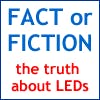Latest
Absorption correction - how to avoid a common LED testing error
Even when correctly calibrated, an integrating sphere does not necessarily provide error-free measurement of an LED's spectral properties, as Greg McKee of Labsphere describes.
LEDs are safe – Fact or Fiction?
Are the latest generation of LEDs safe, or can they cause eye damage? Should they be classified as lasers, or as lamps? Tim Whitaker looks at the different approaches.
Benefits and drawbacks of LEDs
LEDs offer a huge variety of benefits but at the same time they cannot be viewed as the optimum solution for every lighting-related application. Here, in no particular order, we list some of the main advantages of LEDs, together with some of the challenges faced by solid-state lighting devices.
Fact or Fiction – LEDs don’t produce heat
An often-quoted advantage of LEDs is that they don’t produce heat, and are cool to the touch. Fact or fiction?
Metrics for solid-state lighting
What is luminous efficacy? Can color rendering index be applied to LEDs? How do we measure the true cost of light? These and other questions are answered by Kevin Dowling of Color Kinetics.
Industry alliance proposes standard definition for LED life
The light output of LEDs slowly decreases with time, but the absence of a consistent standard for defining and measuring LED lifetime is causing confusion within the lighting community. But an industry group has proposed a solution.
Coming soonPlanned articles will tackle questions such as: * I don’t really need a heatsink, do I? * Why can’t I buy white LEDs with the correct color temperature? * Are LEDs really the most efficient light source known to man? * Why should I pay more for an LED product? If you would like to suggest suitable subjects for articles, or perhaps write one yourself, please contact the editor of LEDs Magazine, Tim Whitaker.






